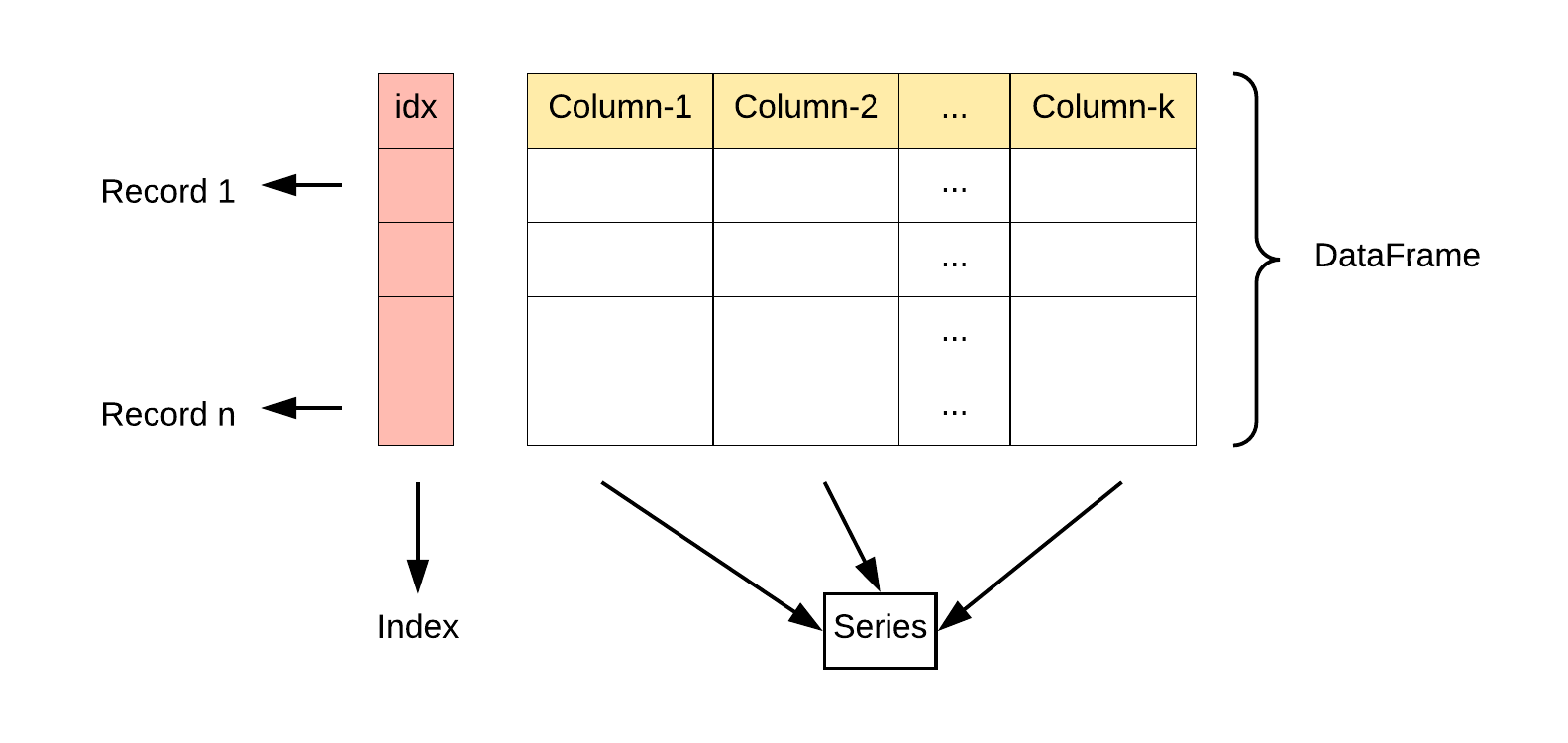Python Pandas DataFrame
Pandas DataFrame是一种二维数据结构,数据在行和列中以表格方式对齐,可以认为就是一个表格。

在Pandas数据结构一节,我们说过在Pandas中高维数据结构是其低维数据结构的容器。比如 DataFrame 是 Series 的容器。所以可以认为 DataFrame数据是由多个Series组成的

DataFrame 的特点
- 列之间可以是不同的类型
- 数据结构大小 可变
- 行和列都可以使用标签进行索引
- 可以对行和列进行算术运算
Pandas DataFrame
可以使用以下方法创建一个 DataFrame 数据
pandas.DataFrame( data, index, dtype, copy)
参数说明如下:
- data:一组数据(ndarray、series, map, lists, dict 等类型)。
- index:索引值,或者可以称为行标签。
- columns:列标签,默认为 RangeIndex (0, 1, 2, …, n) 。
- dtype:数据类型。
- copy:拷贝数据,默认为 False。
创建 DataFrame
可以使用各种数据类型作为输入创建Pandas DataFrame
- 列表
- 字典
- Series
- Numpy 数组
- DataFrame
在本章的后续部分中,我们将看到如何使用这些输入创建 DataFrame。
创建一个空的 DataFrame
可以创建的最基本的 DataFrame 是空 DataFrame。
import pandas as pd
df = pd.DataFrame()
print(df)
运行结果如下
Empty DataFrame
Columns: []
Index: []
使用 列表 创建 DataFrame
可以使用单个列表或一组列表创建 DataFrame。
import pandas as pd
#单个列表创建DataFrame
data = [1,2,3,4,5]
single_df = pd.DataFrame(data)
print(single_df)
#一组列表创建 DataFrame
data = [['Alex',10],['Bob',12],['Clarke',13]]
group_df = pd.DataFrame(data,columns=['Name','Age'])
print(group_df)
运行结果如下
0
0 1
1 2
2 3
3 4
4 5
Name Age
0 Alex 10
1 Bob 12
2 Clarke 13
接下来我们使用一组列表创建DataFrame 并且指定 dtype
import pandas as pd
data = [['Alex',10],['Bob',12],['Jiyik',13]]
df = pd.DataFrame(data,columns=['Name','Age'],dtype=float)
print(df)
运行结果如下
Name Age
0 Alex 10.0
1 Bob 12.0
2 Jiyik 13.0
注意- dtype参数将 Age 列的类型更改为浮点数。但是在Python3中对float类型有警告。
使用ndarrays/Lists 的字典创建一个 DataFrame
所有ndarray必须具有相同的长度。如果传递索引,则索引的长度应等于数组的长度。
如果未传递索引,则默认情况下,索引将为 range(n),其中n是数组长度。
import pandas as pd
#不指定索引
data = {'Name':['Tom', 'Jack', 'Steve', 'Ricky'],'Age':[28,34,29,42]}
df = pd.DataFrame(data)
print(df)
#指定索引
index_df = pd.DataFrame(data, index=['rank1','rank2','rank3','rank4'])
print(index_df)
运行结果如下
Name Age
0 Tom 28
1 Jack 34
2 Steve 29
3 Ricky 42
Name Age
rank1 Tom 28
rank2 Jack 34
rank3 Steve 29
rank4 Ricky 42
使用字典列表创建一个 DataFrame
字典列表可以作为输入数据创建一个 DataFrame。默认情况下,字典键作为列名。
import pandas as pd
data = [{'a': 1, 'b': 2},{'a': 5, 'b': 10, 'c': 20}]
#不指定索引
df = pd.DataFrame(data)
print(df)
#指定行索引
row_index_df = pd.DataFrame(data, index=['first', 'second'])
print(row_index_df)
#指定列行索引和列索引
column_index_df1 = pd.DataFrame(data, index=['first', 'second'], columns=['a', 'b'])
print(column_index_df1)
#指定列行索引和列索引 不存在的列则默认使用 NaN
column_index_df2 = pd.DataFrame(data, index=['first', 'second'], columns=['a', 'b','c1'])
print(column_index_df2)
运行结果如下
a b c
0 1 2 NaN
1 5 10 20.0
a b c
first 1 2 NaN
second 5 10 20.0
a b
first 1 2
second 5 10
a b c1
first 1 2 NaN
second 5 10 NaN
注意- 观察,column_index_df2 DataFrame 是使用字典键以外的列索引 c1 创建的;因此,该列显示 NaN 。
从 Series 字典创建数据帧
可以传递 Series 字典 来创建 DataFrame。结果索引是所有传递的 Series 索引的并集。
import pandas as pd
d = {'one' : pd.Series([1, 2, 3], index=['a', 'b', 'c']),
'two' : pd.Series([1, 2, 3, 4], index=['a', 'b', 'c', 'd'])}
df = pd.DataFrame(d)
print(df)
运行结果如下
one two
a 1.0 1
b 2.0 2
c 3.0 3
d NaN 4
注意- 对于Series one,没有标签“d”,但在结果中,对于d标签,则只能显示NaN。
访问 列
d = {'one' : pd.Series([1, 2, 3], index=['a', 'b', 'c']),
'two' : pd.Series([1, 2, 3, 4], index=['a', 'b', 'c', 'd'])}
df = pd.DataFrame(d)
print(df ['one'])
运行结果如下
a 1.0
b 2.0
c 3.0
d NaN
Name: one, dtype: float64
添加列
我们将通过向现有 DataFrame 添加新列来理解该知识点。
import pandas as pd
d = {'one' : pd.Series([1, 2, 3], index=['a', 'b', 'c']),
'two' : pd.Series([1, 2, 3, 4], index=['a', 'b', 'c', 'd'])}
df = pd.DataFrame(d)
#向现有的DataFrame添加一个新列
print ("Adding a new column by passing as Series:")
df['three']=pd.Series([10,20,30],index=['a','b','c'])
print(df)
print ("Adding a new column using the existing columns in DataFrame:")
df['four']=df['one']+df['three']
print(df)
运行结果如下
Adding a new column by passing as Series:
one two three
a 1.0 1 10.0
b 2.0 2 20.0
c 3.0 3 30.0
d NaN 4 NaN
Adding a new column using the existing columns in DataFrame:
one two three four
a 1.0 1 10.0 11.0
b 2.0 2 20.0 22.0
c 3.0 3 30.0 33.0
d NaN 4 NaN NaN
删除列
可以从DataFrame中删除或弹出列;让我们举一个例子。
import pandas as pd
d = {'one' : pd.Series([1, 2, 3], index=['a', 'b', 'c']),
'two' : pd.Series([1, 2, 3, 4], index=['a', 'b', 'c', 'd']),
'three' : pd.Series([10,20,30], index=['a','b','c'])}
df = pd.DataFrame(d)
print ("Our dataframe is:")
print(df)
#删除
print ("Deleting the first column using DEL function:")
del df['one']
print(df)
#弹出
print ("Deleting another column using POP function:")
df.pop('two')
print(df)
运行结果如下
Our dataframe is:
one two three
a 1.0 1 10.0
b 2.0 2 20.0
c 3.0 3 30.0
d NaN 4 NaN
Deleting the first column using DEL function:
two three
a 1 10.0
b 2 20.0
c 3 30.0
d 4 NaN
Deleting another column using POP function:
three
a 10.0
b 20.0
c 30.0
d NaN
行的访问、添加和删除
我们现在将通过示例了解行检索、添加和删除。
检索行
行的检索可以通过 标签、位置和切片的方式来进行
import pandas as pd
d = {'one' : pd.Series([1, 2, 3], index=['a', 'b', 'c']),
'two' : pd.Series([1, 2, 3, 4], index=['a', 'b', 'c', 'd'])}
df = pd.DataFrame(d)
#标签检索
print("Access By Label:")
print(df.loc['b'])
#位置索引
print("Access By Position:")
print(df.iloc[2])
#切片方式检索
print("Access By Slicing:")
print(df[2:4])
运行结果如下
Access By Label:
one 2.0
two 2.0
Name: b, dtype: float64
Access By Position:
one 3.0
two 3.0
Name: c, dtype: float64
Access By Slicing:
one two
c 3.0 3
d NaN 4
添加行
使用append函数向 DataFrame 添加新行。此函数将在末尾追加行。
import pandas as pd
df = pd.DataFrame([[1, 2], [3, 4]], columns = ['a','b'])
df2 = pd.DataFrame([[5, 6], [7, 8]], columns = ['a','b'])
df = df.append(df2)
print(df)
运行结果如下
a b
0 1 2
1 3 4
0 5 6
1 7 8
删除行
使用索引标签从 DataFrame 中删除行。如果标签重复,则将删除多行。
在上面的示例中,标签是重复的。让我们删除一个标签,看看有多少行会被删除。
import pandas as pd
df = pd.DataFrame([[1, 2], [3, 4]], columns = ['a','b'])
df2 = pd.DataFrame([[5, 6], [7, 8]], columns = ['a','b'])
df = df.append(df2)
df = df.drop(0)
print(df)
运行结果如下
a b
1 3 4
1 7 8
在上面的示例中,删除了两行,因为这两行包含相同的标签 0。
